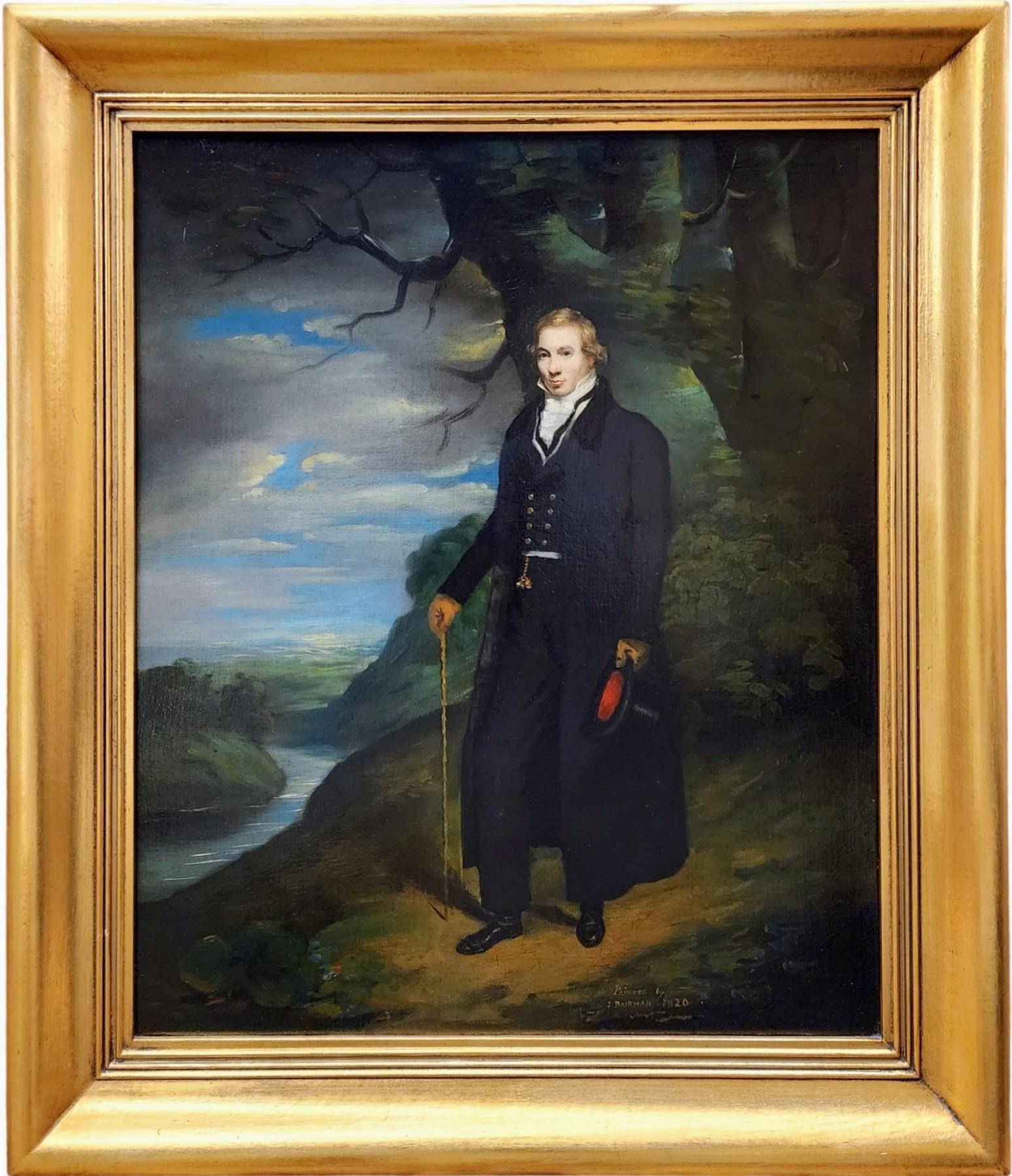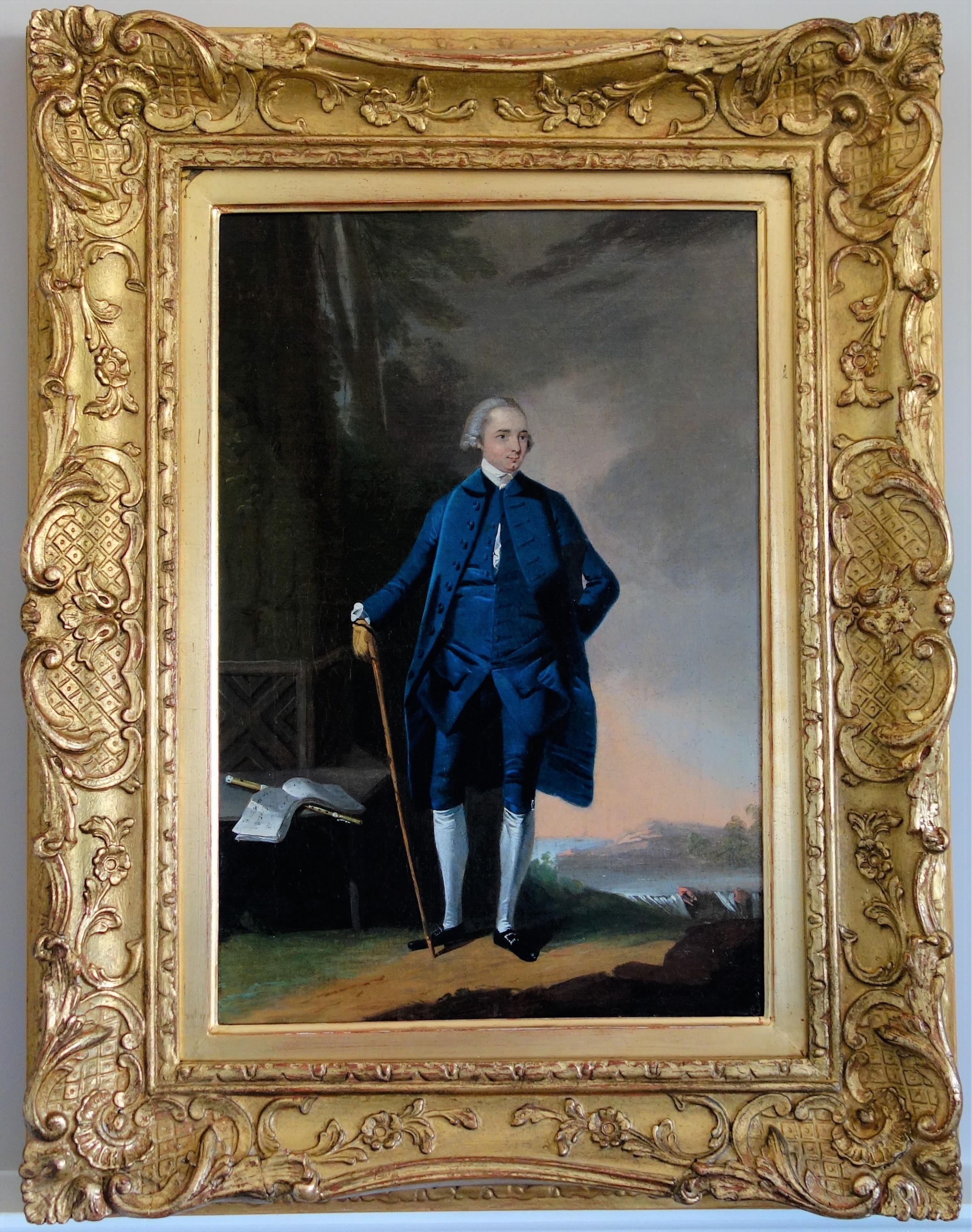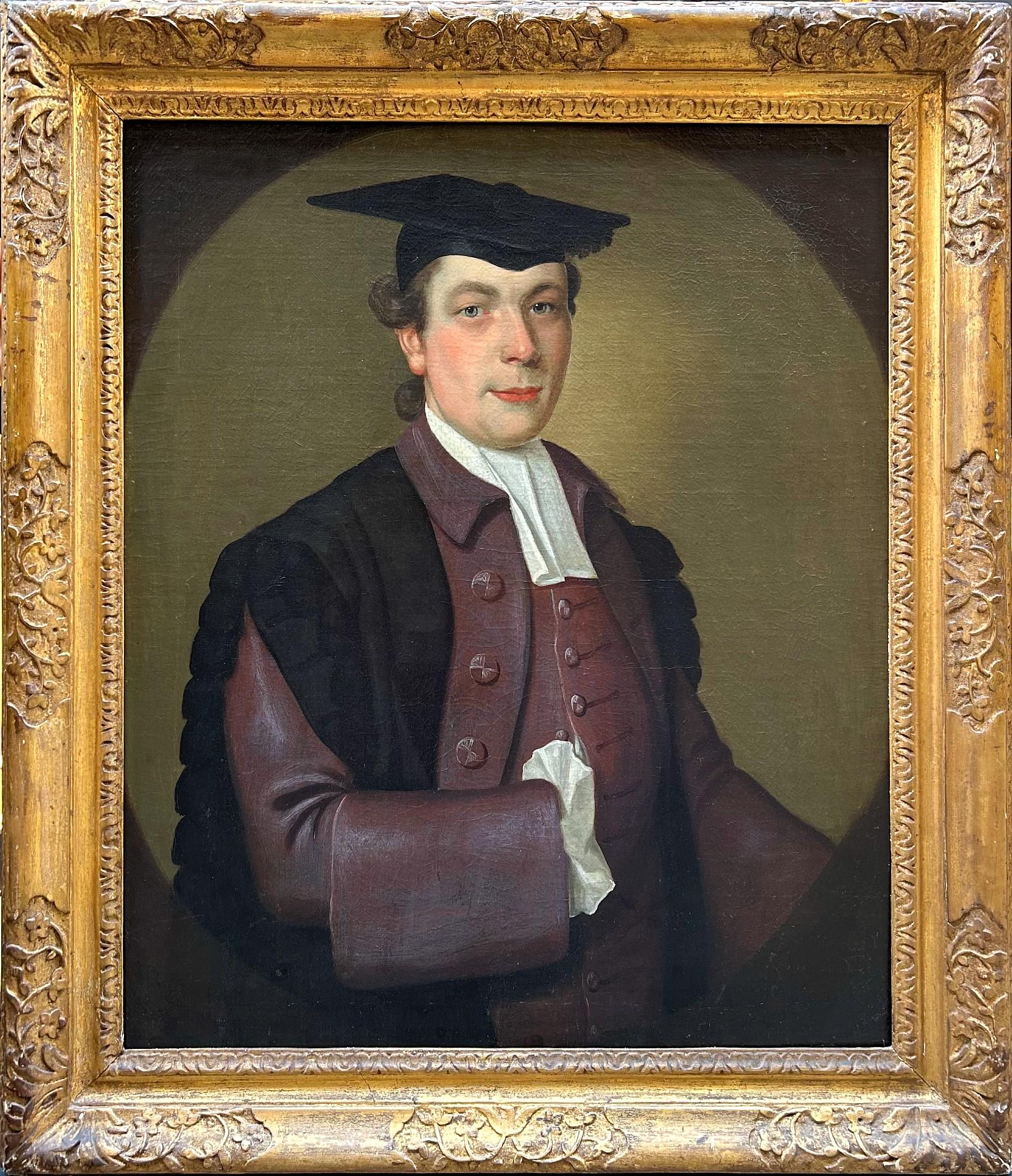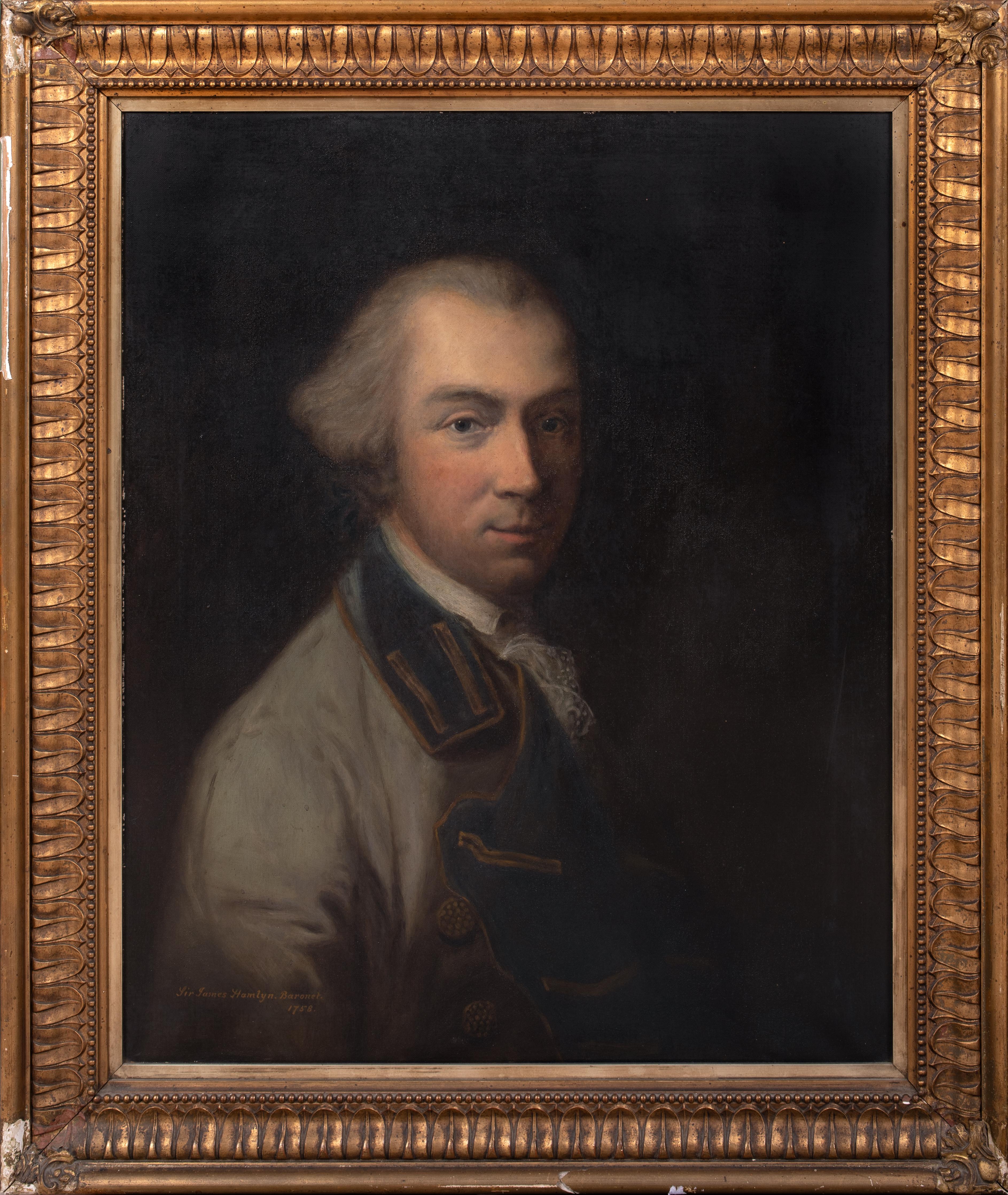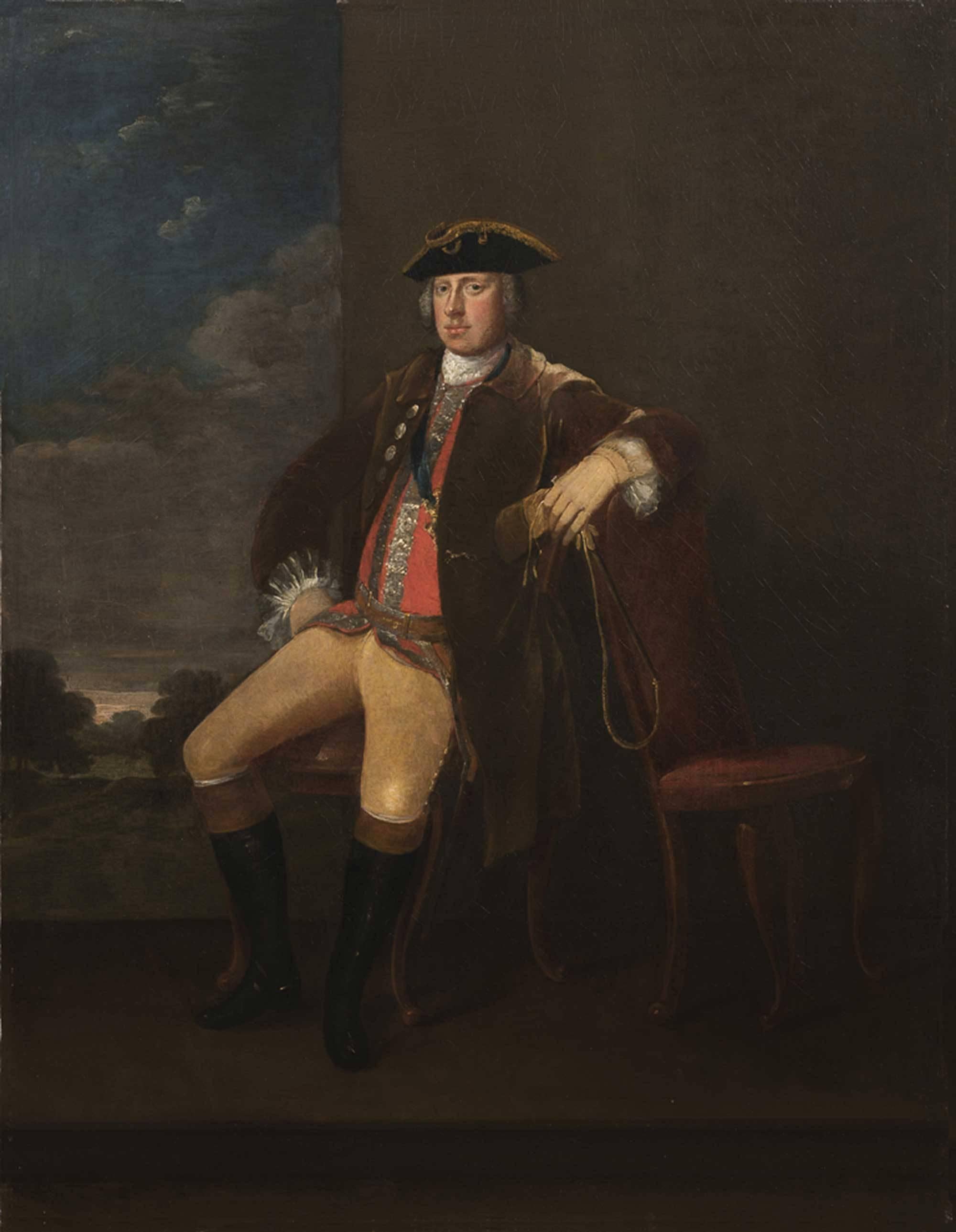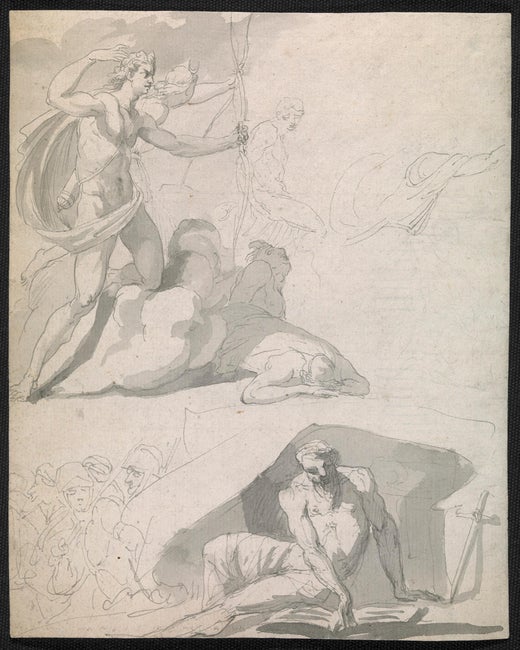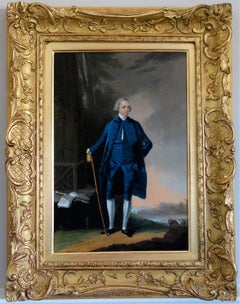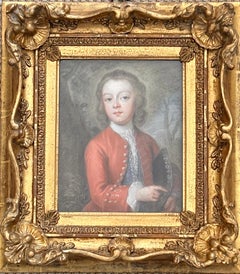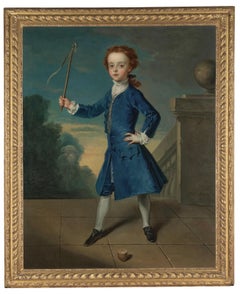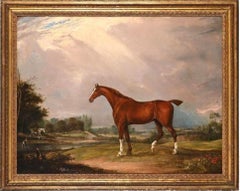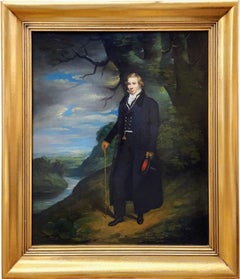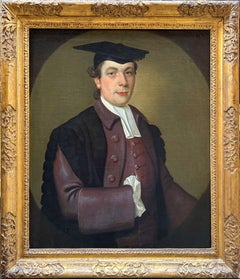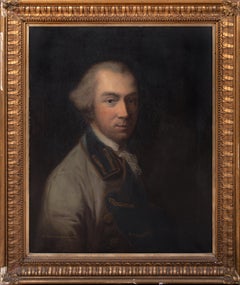Items Similar to An English 18th century portrait of James Stanley, standing in a landscape
Want more images or videos?
Request additional images or videos from the seller
1 of 11
John Hamilton MortimerAn English 18th century portrait of James Stanley, standing in a landscapecirca 1775
circa 1775
$18,749.11
$23,436.3920% Off
£13,600
£17,00020% Off
€15,881.34
€19,851.6820% Off
CA$25,923.99
CA$32,404.9820% Off
A$28,461.30
A$35,576.6320% Off
CHF 14,848.32
CHF 18,560.4020% Off
MX$344,421.39
MX$430,526.7420% Off
NOK 186,100.68
NOK 232,625.8520% Off
SEK 175,355.77
SEK 219,194.7120% Off
DKK 118,549.99
DKK 148,187.4820% Off
About the Item
Portrait of James Stanley (1750 - 1810), circa 1775-1778, full-length, wearing a red coat and breeches and a gold embroidered waistcoat, holding his hat whilst resting on his cane under a tree in a woodland park landscape.
Oil on canvas in a carved giltwood frame decorated with floral and shell motifs
Dimensions:
(Canvas) 29 in. (H) x 23.75 in. (W)
(Frame) 36.75 in. (H) x 31.5 in. (W)
Provenance:
With the sitter, James Stanley (1750-1810), and thence by descent to his grandson;
Edward James Stanley, who married Mary Dorothy Labouchere (1843-1920), eldest daughter of Henry Labouchere, Lord Taunton (1798-1869);
By descent to their son E. A. V. Stanley;
Sotheby, Wilson & Hodge, 14 July 1920, lot 174;
Private Collection, United Kingdom
James Stanley was born in 1750. He was the grandfather of Edward James Stanley, who married Mary Dorothy Labouchere, eldest daughter of Henry Labouchere, Lord Taunton (1798-1869).
Lord Taunton was a prominent Whig and Liberal politician and also formed a wide-ranging art collection of very high quality. He lived at Stoke Park, Stoke Poges, but later moved to a larger house, Quantock Lodge near Over Stowey, which he built between 1856 and 1868 to accommodate his collection. After his death Quantock Lodge and the art collection passed by descent to Edward Arthur Vesey Stanley, who sold part of it at auction. Included was the present portrait, which had come into Lord Taunton’s collection from the Stanley family.
The 14 July 1920 sale was conducted by Sotheby, Wilkinson & Hodge, the present work sold as lot 174: 'Zoffany (attributed to). Portrait of a gentleman: whole-length, walking towards the right in a landscape; in red coat and breeches and embroidered waistcoat. Canvas, 29 x 24 ins.'
John Hamilton Mortimer was born on 17 September 1740 in Eastbourne, Sussex, the fifth and youngest child of Thomas Mortimer (1697-1774), a mill owner and customs officer, and his wife, Catherine, née Smith (d. 1746).
He may have received some instruction in painting from a paternal uncle, Roger Mortimer (1700-1769), an itinerant artist. In 1756 or 1757 Mortimer's father paid £100 for him to be placed in London for three years in the studio of the portrait painter Thomas Hudson (1701-1779). Finding Hudson's studio regime quite rigid, Mortimer was by March 1759 working under Robert Edge Pine (1730-1788), a history painter and portraitist of republican views who later moved to America. Although Mortimer did not stay with Pine for long, he was influenced by his painting style, his subject matter, and probably his radical political views. Mortimer embraced the opportunity for developing his drawing skills and contact with other students and artists in London which he found in the Duke of Richmond's Sculpture Gallery, the St Martinis Lane Academy and Shipley's Drawing Academy. Mortimer won prizes offered by the Society for the Encouragement of Arts, Manufactures, and Commerce, for drawings done in the Duke of Richmond's Sculpture Gallery and the St Martin's Lane Academy. Mortimer met the painter Joseph Wright of Derby (1734 - 1797), with whom he became friends, in Hudson's studio, and in Shipley's drawing school he probably met two of his closest artist friends, Thomas Jones (1742-1803) and James Gandon (1742-1823).
In 1750 the Society for the Encouragement of Arts, Manufactures, and Commerce began to offer premiums for English (and later British) history painting. Mortimer won second prize in 1763 and in 1764 he won the first prize for St Paul Preaching to the Ancient Britons (Guildhall, High Wycombe, Buckinghamshire). This success established his reputation as a history painter. Alongside this, he painted portraits and particularly group portraits, in the style of John Zoffany and Francis Wheatley.
Mortimer exhibited at the Society of Artists every year from 1762 until 1777. Unlike many of the older established artists he did not transfer to the Royal Academy on its foundation in 1768, but remained loyal to the Society of Artists along with more radical artists such as Joseph Wright of Derby. He was active in setting up the Society's academy of drawing and painting in Maiden Lane, Covent Garden, in 1769, having become a director of the Society in 1768. He was made vice-president in 1770 and was president in 1774-5.
Mortimer collaborated on works with other artists during the 1760s and early 1770s, no doubt largely as a result of friendships formed in the drawing academies and the Society of Artists. He painted figures in landscapes by Thomas Jones before the latter's departure for Italy in 1776, and he worked with Richard Paton, introducing some figures into Paton's views of the royal dockyards, 1770-71 (Royal Collection). He painted a large decorative ceiling for the saloon of Brocket Hall, Hertfordshire (c.1770-73), in which he was assisted by Francis Wheatley and James Durno.
- Creator:John Hamilton Mortimer (1740 - 1779, English)
- Creation Year:circa 1775
- Dimensions:Height: 36.75 in (93.35 cm)Width: 31.5 in (80.01 cm)
- Medium:
- Movement & Style:
- Period:1770-1779
- Condition:
- Gallery Location:Bath, GB
- Reference Number:1stDibs: LU95213186712
John Hamilton Mortimer
John Hamilton Mortimer was a British figure and landscape painter and printmaker, known for romantic paintings set in Italy, works depicting conversations and works drawn in the 1770s portraying war scenes, similar to those of Salvator Rosa. Mortimer became President of the Society of Artists in 1774, five years before his death, at age 39.
About the Seller
5.0
Vetted Professional Seller
Every seller passes strict standards for authenticity and reliability
Established in 2002
1stDibs seller since 2015
37 sales on 1stDibs
Associations
The British Antique Dealers' AssociationLAPADA - The Association of Arts & Antiques DealersInternational Confederation of Art and Antique Dealers' Associations
- ShippingRetrieving quote...Shipping from: Bath, United Kingdom
- Return Policy
Authenticity Guarantee
In the unlikely event there’s an issue with an item’s authenticity, contact us within 1 year for a full refund. DetailsMoney-Back Guarantee
If your item is not as described, is damaged in transit, or does not arrive, contact us within 7 days for a full refund. Details24-Hour Cancellation
You have a 24-hour grace period in which to reconsider your purchase, with no questions asked.Vetted Professional Sellers
Our world-class sellers must adhere to strict standards for service and quality, maintaining the integrity of our listings.Price-Match Guarantee
If you find that a seller listed the same item for a lower price elsewhere, we’ll match it.Trusted Global Delivery
Our best-in-class carrier network provides specialized shipping options worldwide, including custom delivery.More From This Seller
View All18th century portrait of the German Flautist and composer Johann Joachim Quantz
By Arthur Devis
Located in Bath, Somerset
Portrait of Johann Quantz (1697-1773), flautist and composer, wearing a blue velvet coat, waistcoat and breeches, standing in a garden landscape with ...
Category
18th Century English School Portrait Paintings
Materials
Canvas, Oil
$14,879 Sale Price
20% Off
18th century pastel portrait of a young boy in a wooded landscape
By Arthur Pond
Located in Bath, Somerset
This little jewel of a pastel of a young boy in his smart red jacket and silver trimmed waistcoat is by an artist working in the circle of Arthur Pond and ...
Category
18th Century English School Portrait Paintings
Materials
Pastel
$7,715 Sale Price
20% Off
18th century portrait painting of a boy with a spinning top on a garden terrace
Located in Bath, Somerset
Portrait of a young boy, full-length in a blue velvet coat and breeches, standing on a stone terrace in a garden landscape, playing with a spinning top. Signed and dated ' Phil. Merc...
Category
1740s Old Masters Portrait Paintings
Materials
Canvas, Oil
English early 19th century painting of a chestnut hunter in a landscape
By John Ferneley Senior
Located in Bath, Somerset
A painting of a chestnut hunter in a landscape with a horse and rider accompanied by two hounds by a woodland river in the distance.
Signed and inscribed 'Melton Mowbray', lower left.
Oil on canvas in a giltwood frame.
John Ferneley Sr (1782-1860) was born the son of a Leicestershire wheelwright, the youngest of six children. He is known as one of the great British equine artists, perhaps only second to Stubbs in terms of raw ability.
Ferneley originally worked with his father, until by chance the Duke of Rutland saw some of his work on the side of a cart on which Ferneley and his father had been working. The Duke was so impressed with Ferneley that he persuaded John's father to allow him to become the pupil of Benjamin Marshall. Ferneley was so talented that apparently he produced almost perfect copies of his tutor's paintings and they were said to have been indistinguishable from the master’s. Marshall also enrolled him as a student of the Royal Academy Schools.
In 1804 Ferneley paid a man named Thomas Harrison...
Category
Early 19th Century English School Animal Paintings
Materials
Canvas, Oil
18th century painting of the Dalbiac family in the gardens of a country house
By Charles Philips
Located in Bath, Somerset
The painting depicts James (Jacques) Dalbiac, his wife Louise (ne de la Porte) and their five children, James, Charles, Louise, Marianne and Martha in the ornamental gardens of a grand country estate.
The extensive gardens extend into the distance with gardeners working in the background and figures strolling through the avenues of trees. A peacock and peahen can be seen on the wall to the left and a potted orange tree to the right. Louise Dalbiac holds an orange taken from the orange tree, aluding to the family's faith and their loyalty to the protestant King William of Orange and their adopted country.
The Dalbiacs were wealthy London silk and velvet merchants of French Huguenot origin who had fled France at the end of the 17th century to escape persecution for their protestant faith. England offered safe refuge and their skills and industriousness allowed them to establish one of the most successful businesses in London's Spitalfields which became a new centre of the silk trade, effectively leading to the collapse of the once dominant French silk industry. Both sons, James and Charles followed their father and Uncle into the family business, successfully growing the family's fortune and each going on to own their own country estates.
A conversation piece is a genre of painting used to describe group portraits of families and friends, often depicted with their servants and family pets and set within an elegantly furnished interior or the garden of a grand country house. They were a celebration of the intimacy of family relations as well as a sign of status, property and the power of succession. The informality of conversation pieces grew popular in 18th century England, allowing the sitters to present themselves in a more relaxed pose, perhaps engaged in intellectual conversation or showing their talents or interests. In this present portrait, the Dalbiacs are shown richly dressed and and at leisure in a grand country house setting, conveying their success and cultural and social aspirations.
Charles Philips (c.1703–1747) was an English artist known for painting a number of portraits and conversation pieces for noble and Royal patrons in the mid-eighteenth century. He was the son of portrait painter Richard Philips...
Category
Early 18th Century Old Masters Portrait Paintings
Materials
Canvas, Oil
English 18th century portrait of a water spaniel dog standing in a landscape
By George Stubbs
Located in Bath, Somerset
Circle of George Stubbs (1724-1806). English 18th century portrait of a water spaniel standing in a wooded landscape.
This charming painting is a wonderful example of the style of English dog painting made popular by artists such as George Stubbs and other sporting artists working in England in the 18th century who painted the dogs and horses of the aristocracy and wealthier classes. It follows in the ancient tradition of celebrating and commemorating our faithful canine companions through portraiture.
Oil on canvas in a giltwood frame
Provenance: Private collection, Somerset
George Stubbs (1724-1806) was classified in his lifetime as a sporting painter, and as such was excluded from full membership of the Royal Academy. He is best remembered for his paintings of horses and his conversation pieces. Having studied anatomy, Stubbs's pictures of horses are among the most accurate ever painted.
Stubbs was born in Liverpool, the son of a leather worker...
Category
18th Century English School Animal Paintings
Materials
Canvas, Oil
$15,981 Sale Price
20% Off
You May Also Like
Portrait of a Gentleman in a Landscape - British Old Master art oil painting
Located in Hagley, England
This superb British 18th century Old Master portrait oil painting is by William Williams of Norwich. It was painted circa 1780, after he had returned to England from in Philadelphia ...
Category
1780s Old Masters Portrait Paintings
Materials
Oil
Portrait of a Gentleman in a Landscape, Scottish Portraiture, Portrait, Wealthy
Located in Grand Rapids, MI
John Pairman (Scottish, 1788 - 1843)
Signed: J Pairman 1820 (Lower, Right)
" Portrait of a Gentleman ", 1820
Oil on Canvas
22 1/4" x 18 5/8"
Housed in a 2 3/4" Husar Frame
Ove...
Category
Early 19th Century Portrait Paintings
Materials
Canvas, Oil
Portrait of a Gentleman Commoner at Oxford, 18th Century Oil on Canvas
By James Northcote b.1746
Located in London, GB
James Northcote
Portrait of a Gentleman Commoner at Oxford
Oil on canvas
Image size: 30 x 25 inches (76 x 63.5 cm)
Original gilt frame
This painting is a comparatively rare example ...
Category
18th Century English School Portrait Paintings
Materials
Canvas, Oil
Portrait Of Sir James Hamlyn (1735-1811), MP for Carmarthen, Sheriff of Devon
By Joshua Reynolds
Located in Blackwater, GB
Portrait Of Sir James Hamlyn (1735-1811), MP for Carmarthen, Sheriff of Devon, 18th Century
follower of Sir Joshua REYNOLDS (1723-1792)
Large 18th Century portrait of Sir James Ham...
Category
18th Century Portrait Paintings
Materials
Canvas, Oil
Portrait of a King's Messenger, 18th Century English Artist, Original Frame
By Charles Philips
Located in London, GB
Charles Philips
1703 - 1747
Portrait of a King's Messenger
Oil on canvas
Image size: 35 ¾ x 28 inches
Original gilt frame
King's Messenger
The job of a King's Messenger was that of a diplomatic courier, hand-carrying important and secret documents around the world. Some say that the history of the sovereigns' messengers goes back to 1199, but the first known messenger was John Norman, who in 1485 earned 4d (1½ pence) per day for carrying the state papers of Richard III.
The silver greyhound on the messenger's badge dates back to Charles II. In 1660, during his exile at Breda, Netherlands, Charles II issued a declaration of amnesty to all those who had opposed him and his father. He used messengers to make his intentions known. In answer to the messenger's question "How will they know me?", Charles reached forward to a silver bowl on the table in front of him. This bowl, with four decorative greyhounds standing proud above the rim, was well known to all courtiers. Charles broke off a greyhound and gave it to the messenger as a guarantee that the message came from him. From that date, the King's Messenger always wore a silver greyhound around his neck.
Later, dating from George II or III, a badge with the Royal Arms in enamel, with the greyhound suspended beneath, was worn. A George III example of the King's Messenger Badge, pre 1800, sold for over £30,000 pounds some years ago.
The silver greyhounds were minted for each new reign, except the brief one of King Edward VIII. The sovereign's messengers were originally controlled by the Lord Chamberlain, being Messengers of the Great Chamber. When the Foreign Office was created in 1782, the messengers remained common to the three Secretaries of State.
Charles Philips was an English artist known for painting a number of portraits and conversation pieces for noble and Royal patrons in the mid-eighteenth century.
Philips was baptised in the combined parish of St Mildred, Poultry with St Mary...
Category
18th Century Portrait Paintings
Materials
Canvas, Oil
Portrait Of 1st Baron Hawkstone, Sir Rowland Hill, Tory MP for Lichfield
By Charles Jervas
Located in Blackwater, GB
Portrait Of 1st Baron Hawkstone, Sir Rowland Hill, Tory MP for Lichfield (1705-1783)
by Charles JERVAS (1675-1739)
Large 18th Century portrait of Baron Hawkstone, Sir Rowland Hill,...
Category
18th Century Portrait Paintings
Materials
Canvas, Oil
More Ways To Browse
Stanley Antique
18th Century English Painting
Maiden Painting
Joseph Wright Of Derby
James Mortimer
Portrait Of James Stanley
Bearded Man Painting
Portraits Of Native Americans
Red Canoe
18th 19th Century Portraits
1928 Olympic
Art Portrait Painting Clown
Belgium Oil Painting Portrait
Jordi Curos
Oil Painting Monk
Jordi Curos Ventura
Modigliani Portrait
Queen Elizabeth Painting

